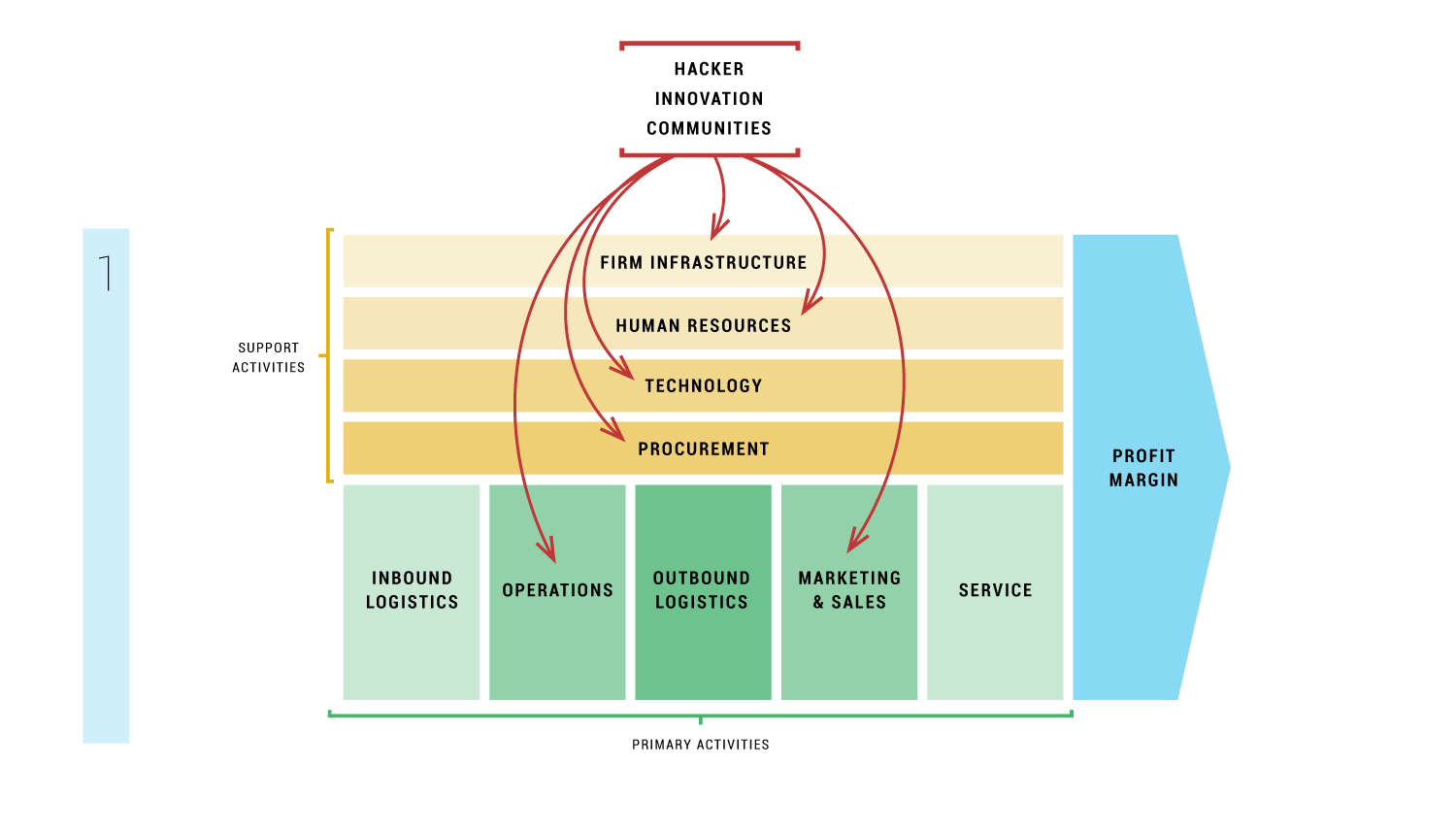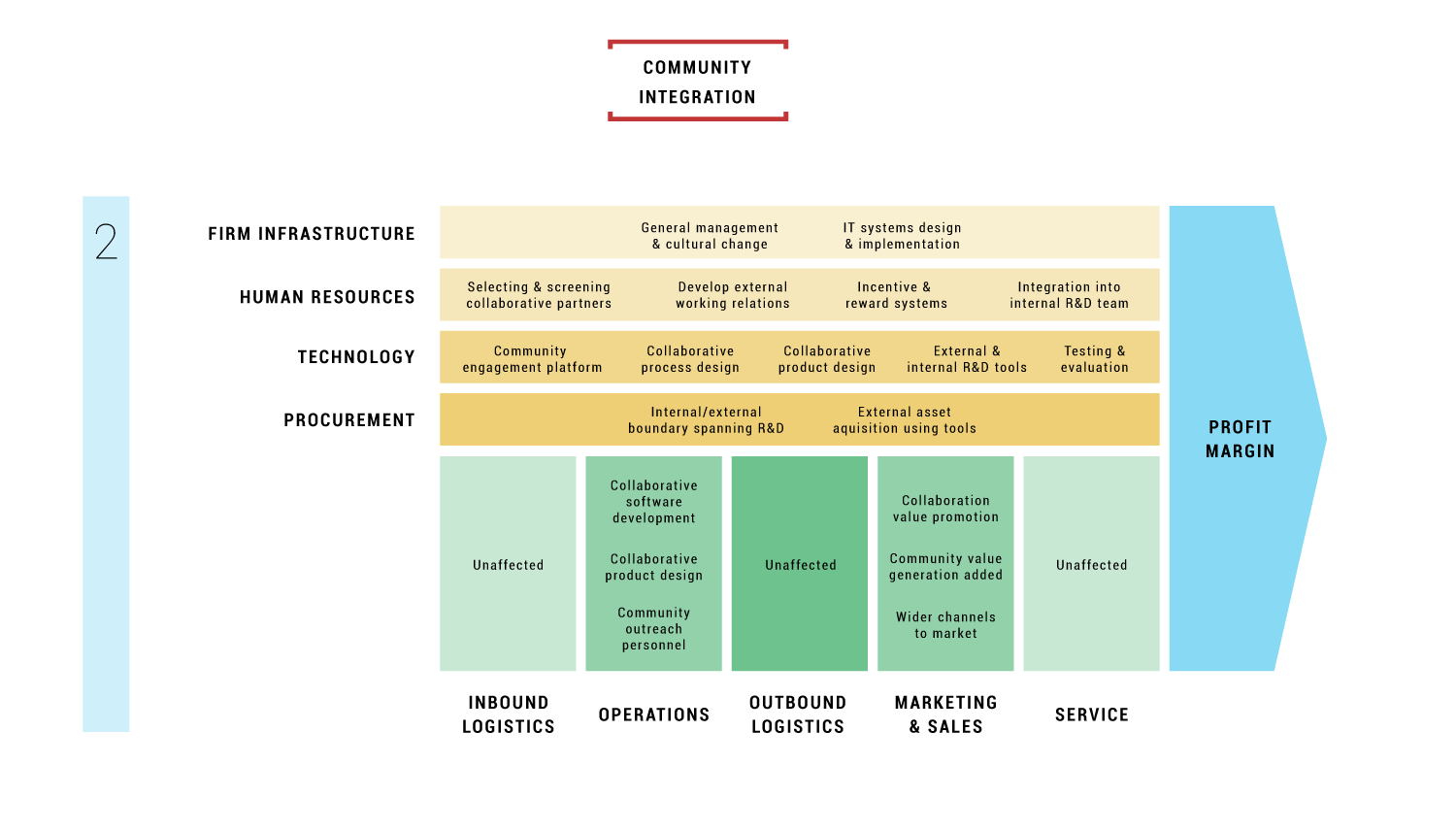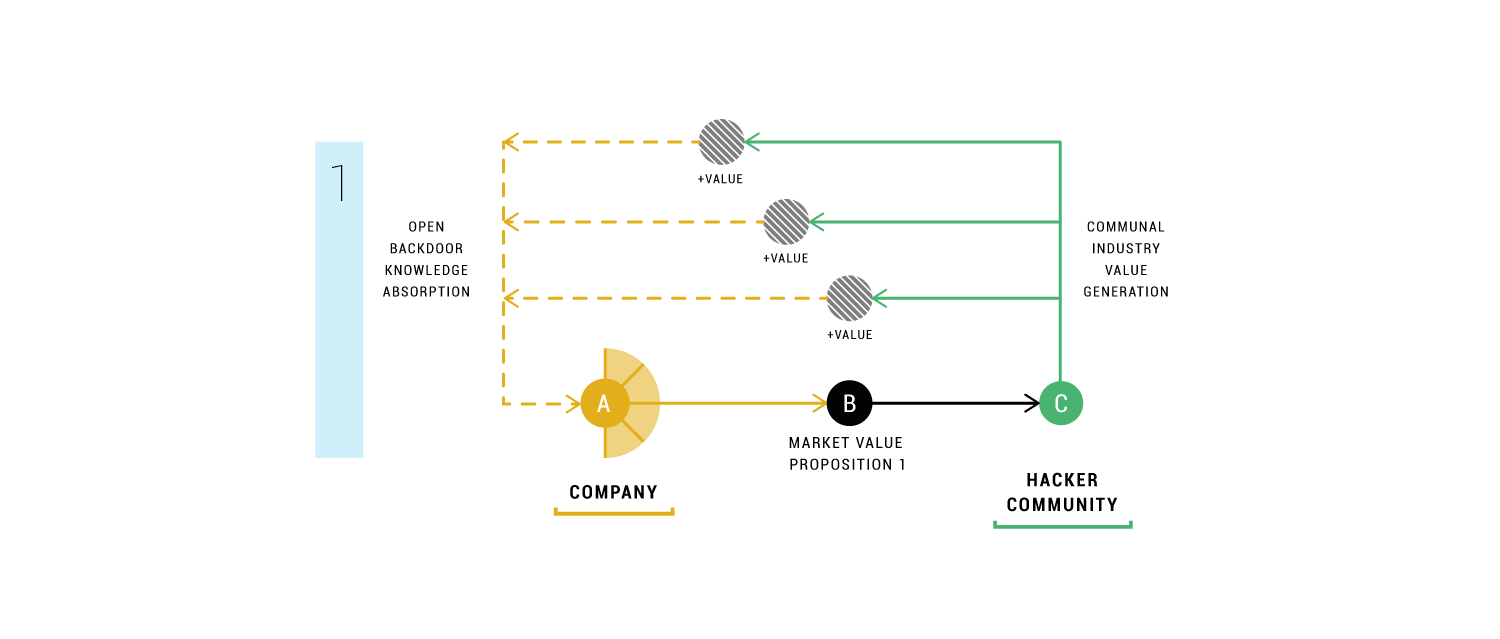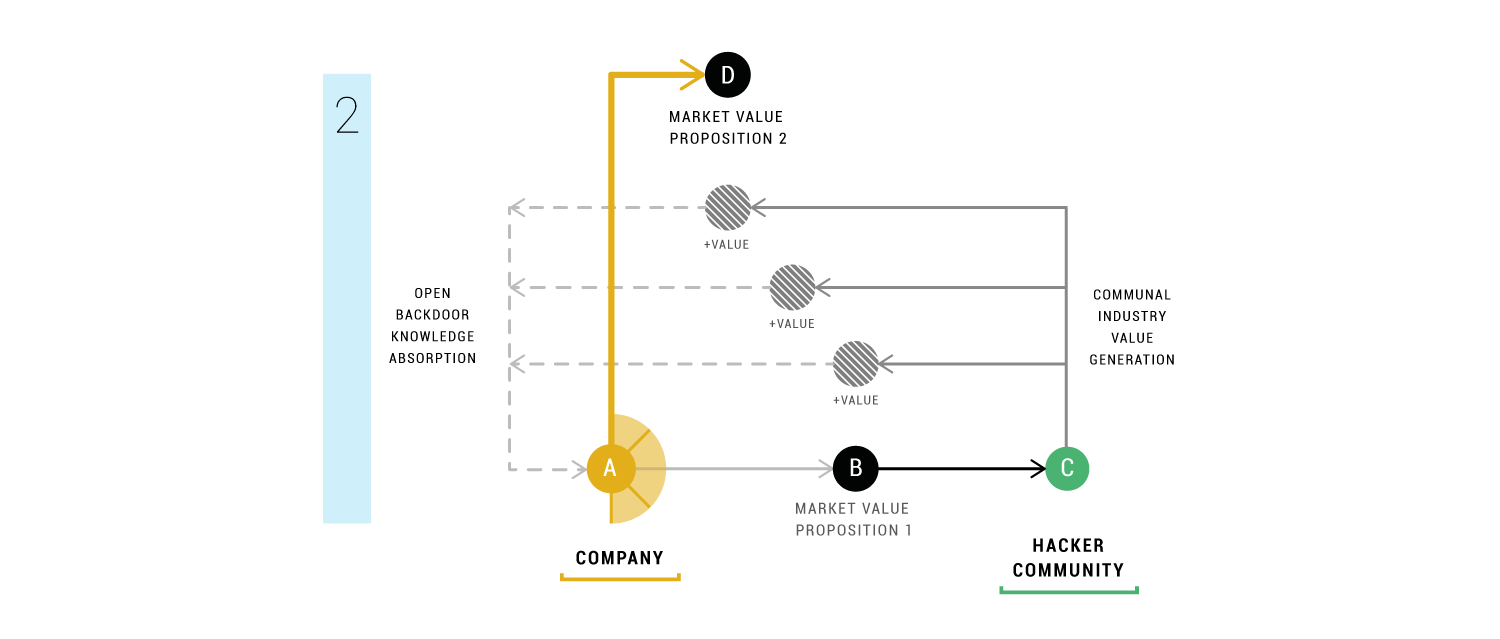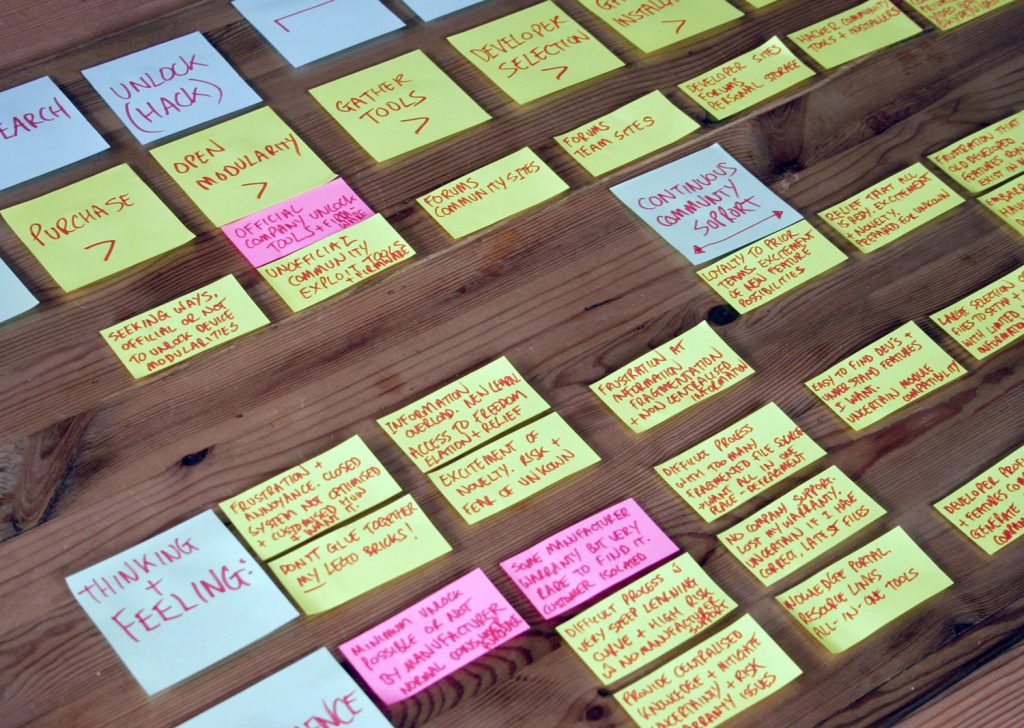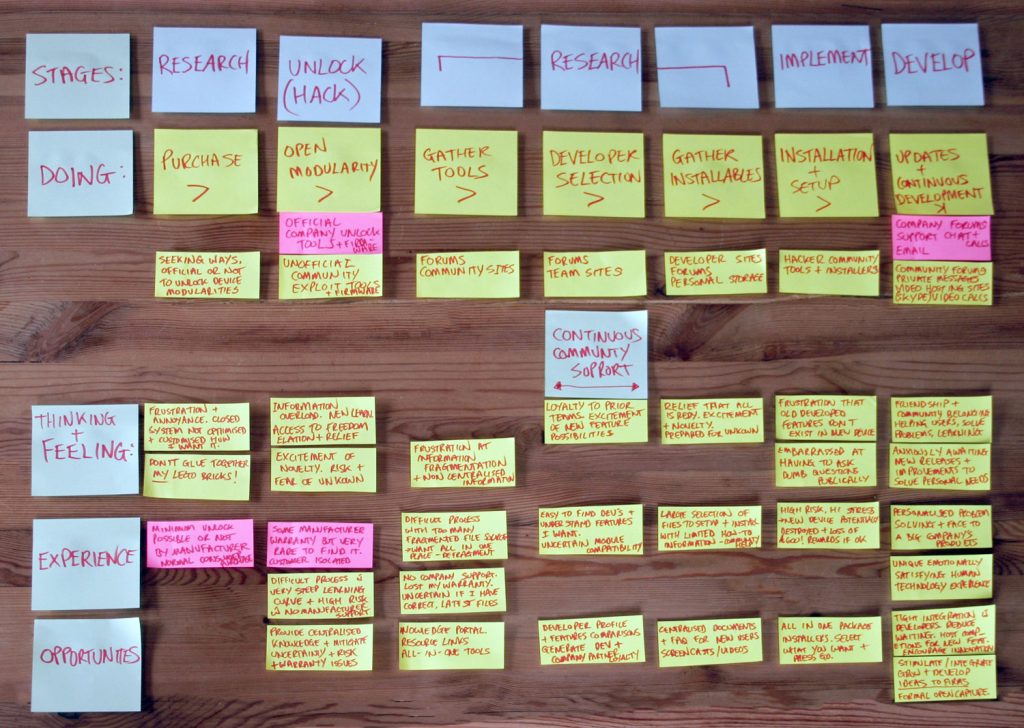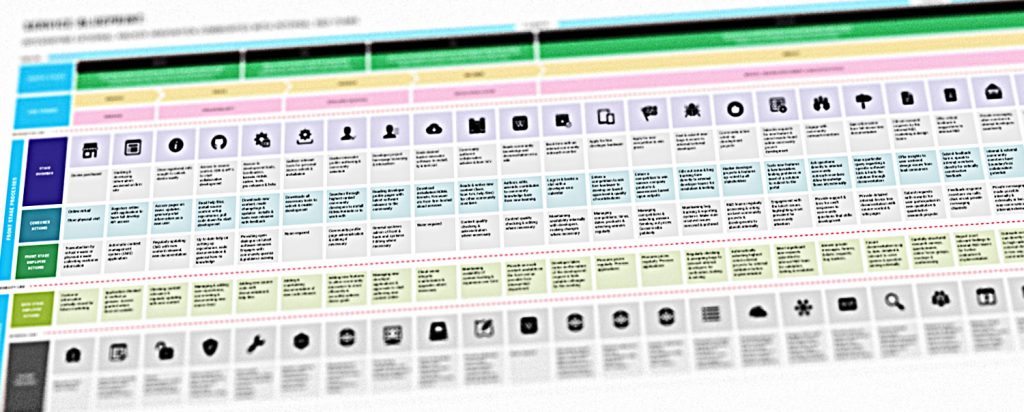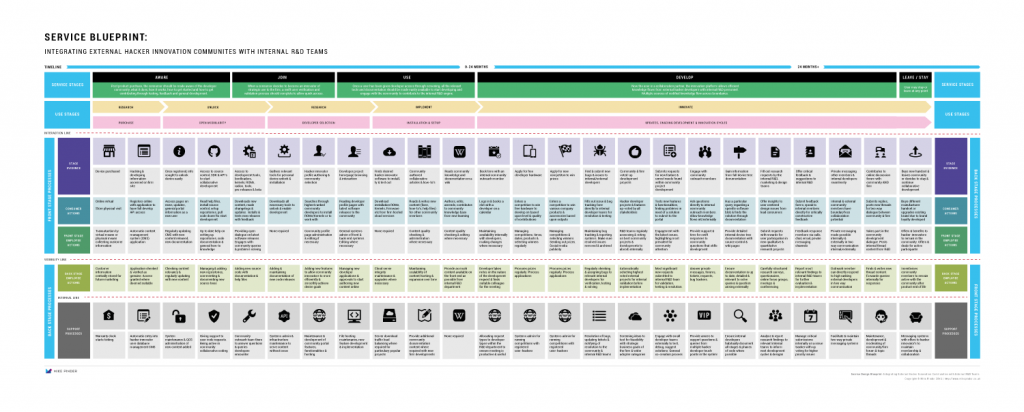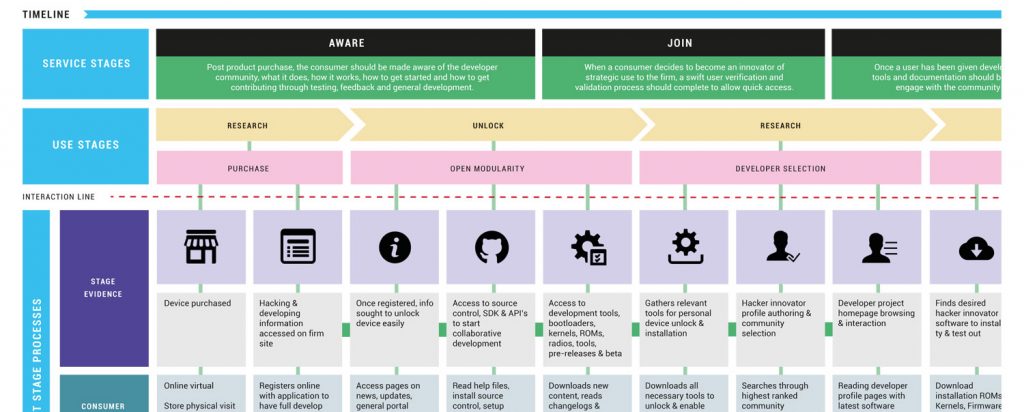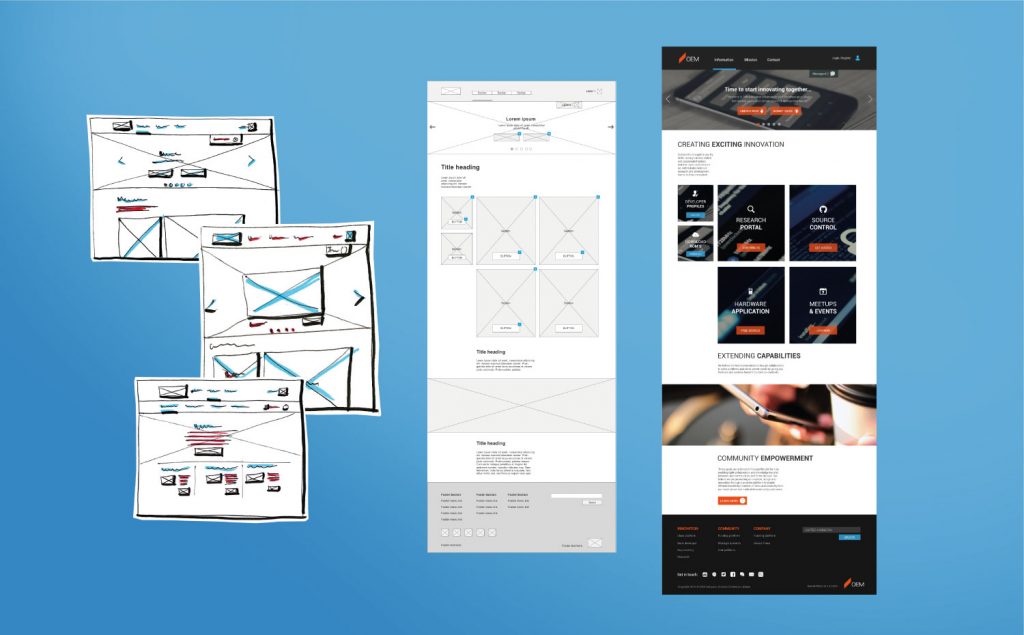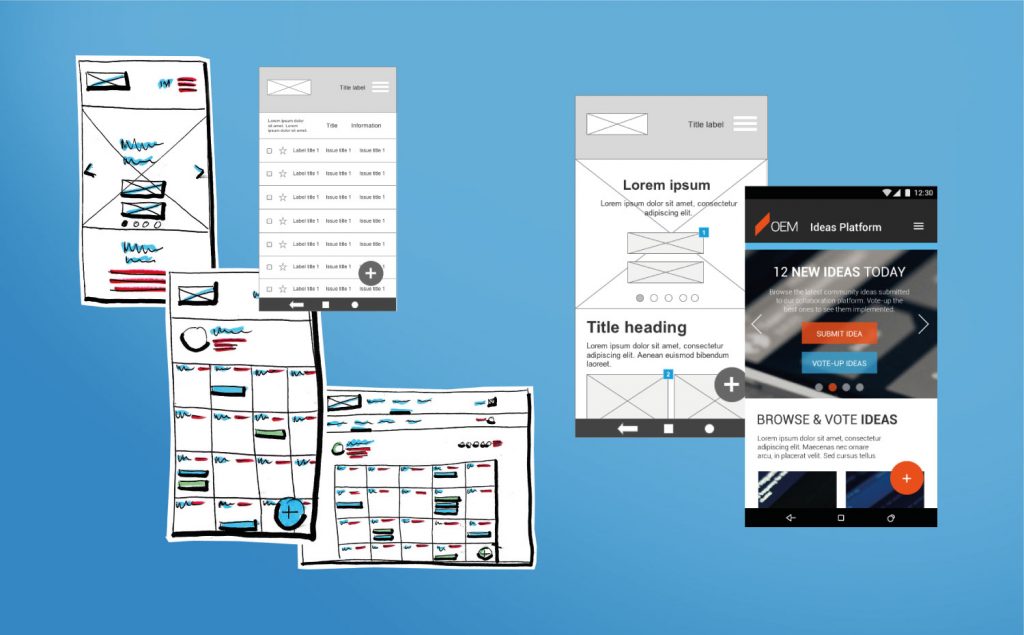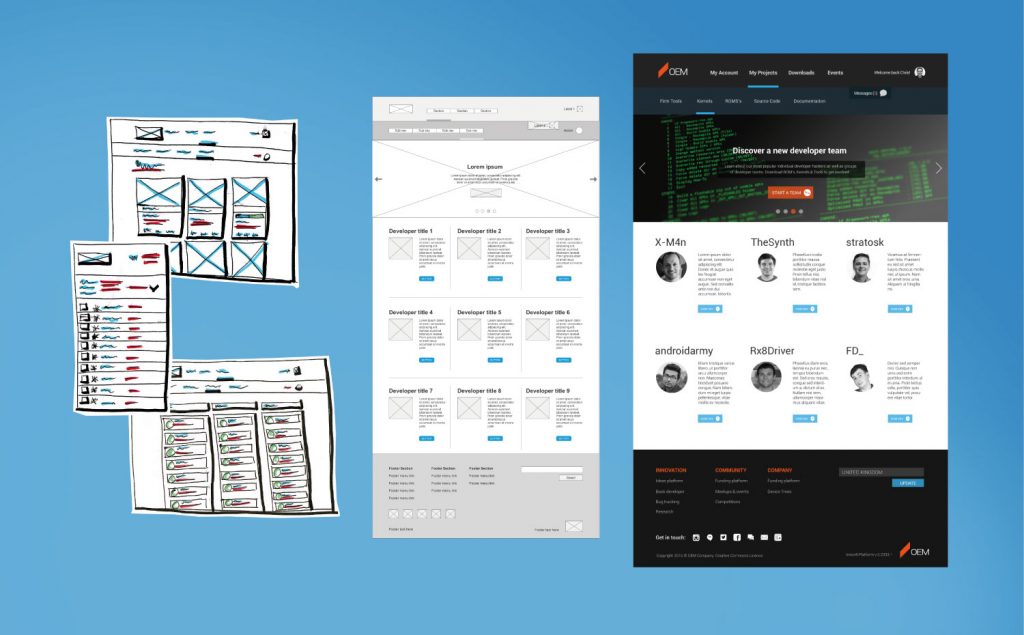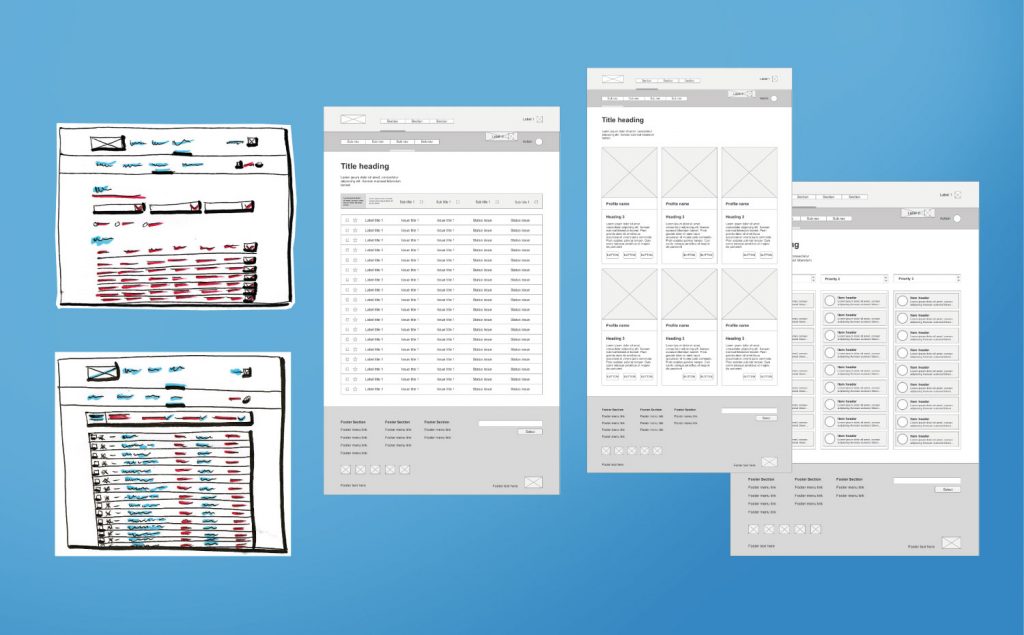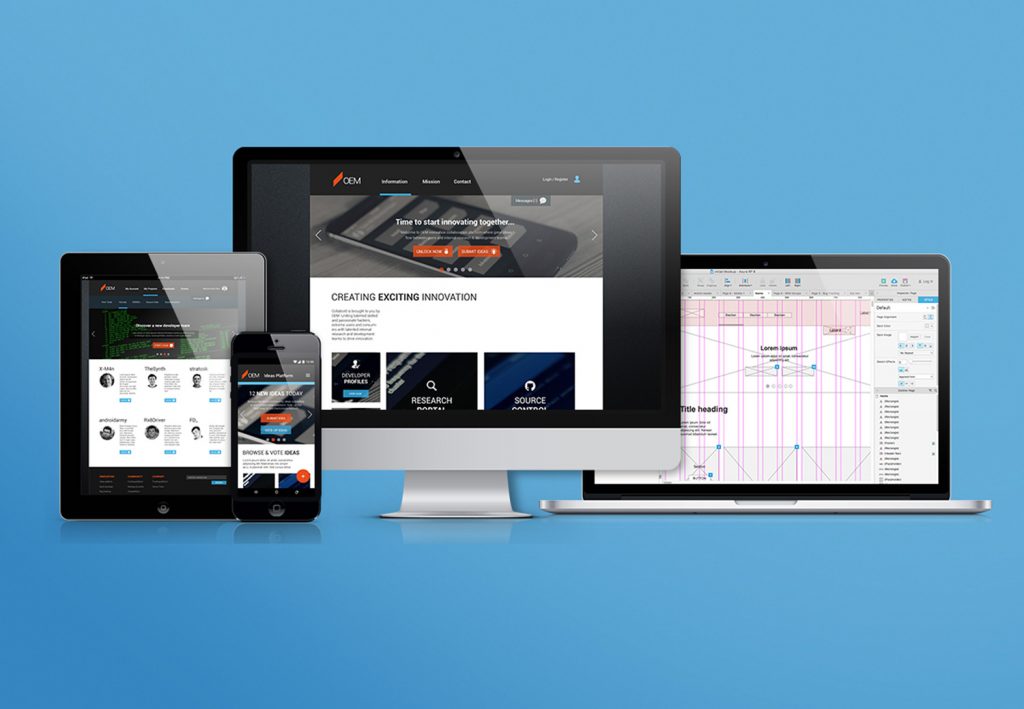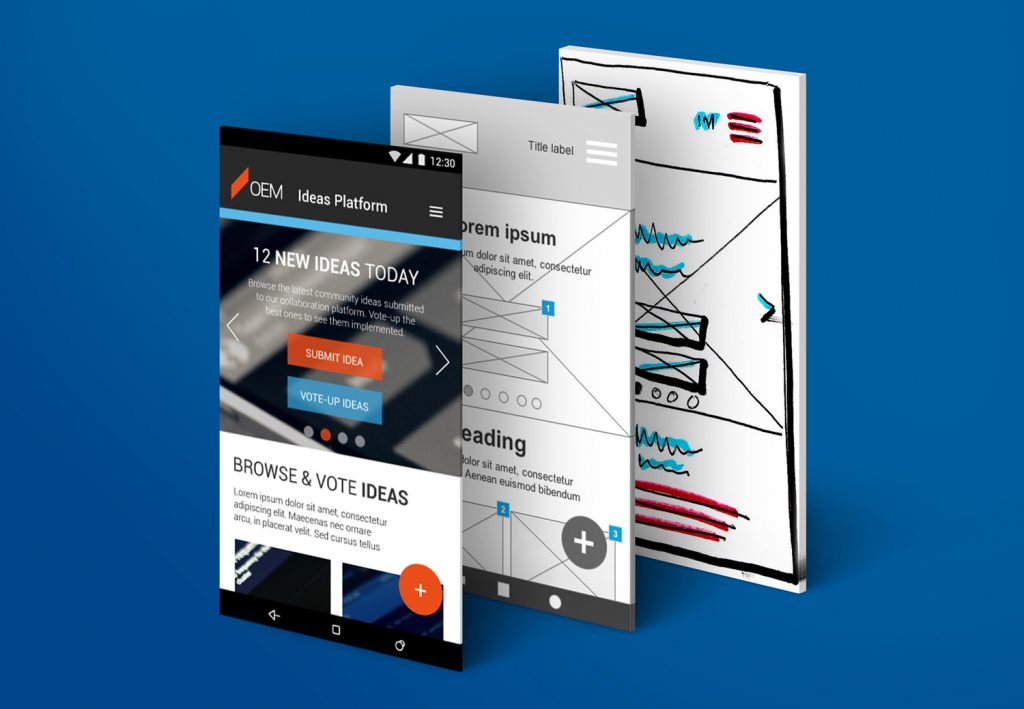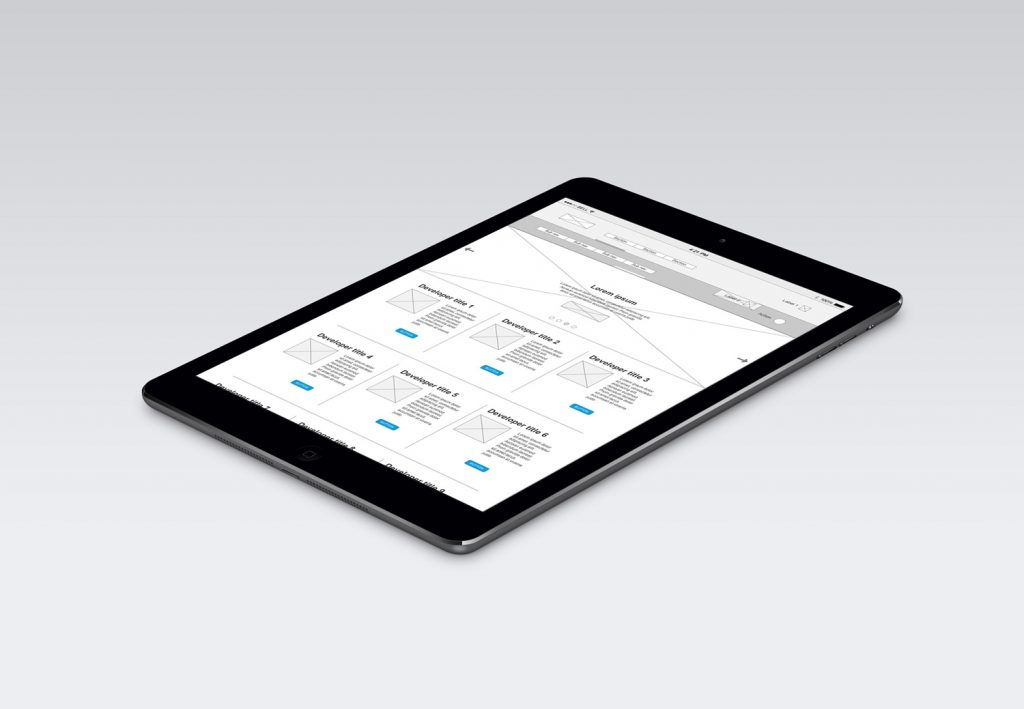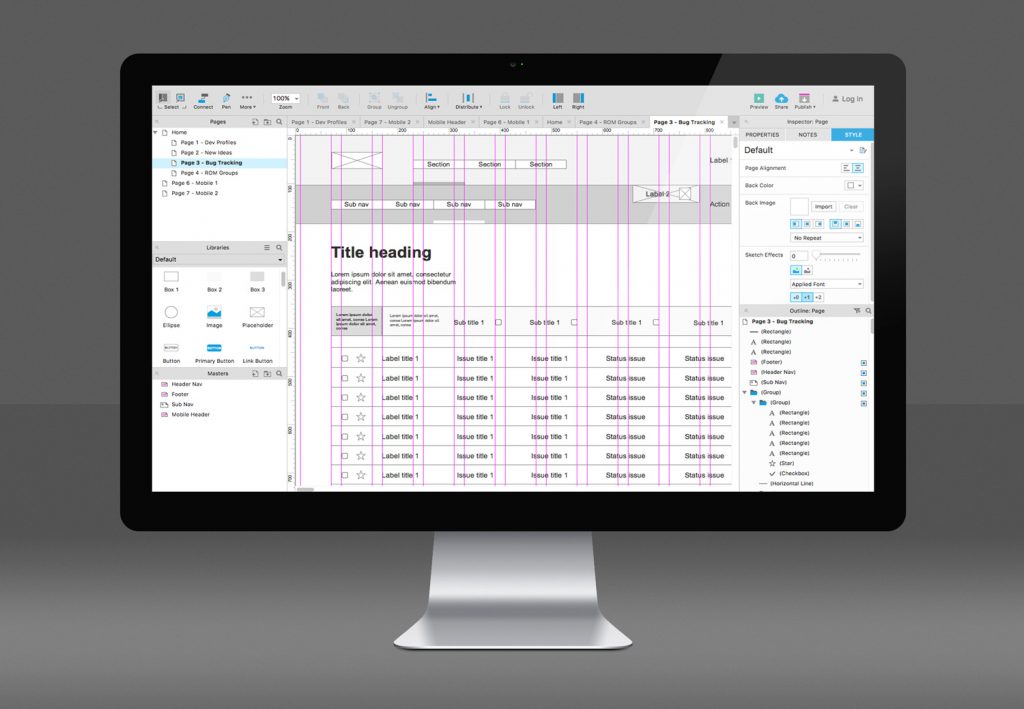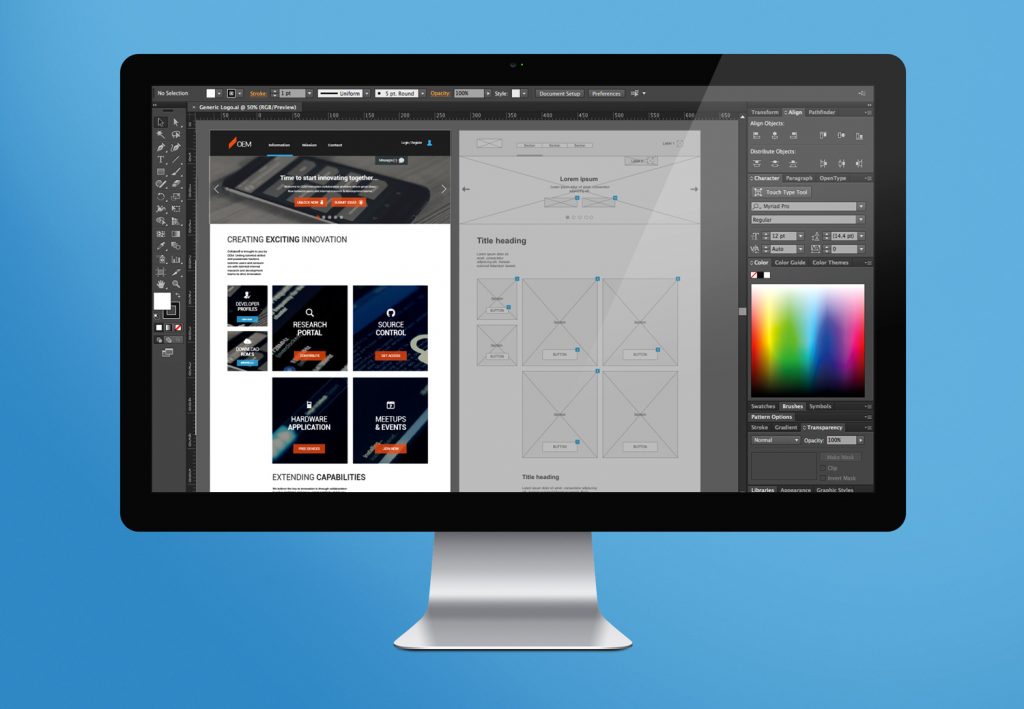My professional practice is based on the following main skill-sets:
My Approach
I combine complementary disciplines spanning design, business and innovation allowing me to work effectively at strategic, tactical and operational levels.
I deploy a range of relevant research tools, design methodologies and approaches to individual project spanning the social sciences, innovation management research, design thinking, service design strategy, qualitative insight research, human centred design (HCD), design management visual design and lean UI/UX rapid prototyping (amongst others).
- Innovation Management Research & Strategy
- Design Research Methods & Strategy
- Design Management
- Design Thinking
- Service Design
- Strategic Management
- Business Management
- Rapid Prototyping (CX/UX/UI)
Overview
i. Case Study: The role of disruptive external innovators on internal innovation at an OEM smartphone manufacturer
The following case study demonstrates my working process and explains my thinking in formulating a tailored approach to design project work using toolsets to address specific business problems in order to develop relevant solutions.
Company Problem
An established OEM manufacturer in the increasingly-competitive smartphone industry noticed the growing prevalence of disruptive end-user developer communities unlocking and modifying underlying software systems to meet specific local needs and desires for customisations and personal preference.
The traditional culture of the firm is to develop products and services in-house, however competitor analysis research revealed that new emerging firms (such as OnePlus. Nextbit, Huawei and others) actively encourage external development and modification of devices by community members, viewed as partners and co-creators of value to drive customer loyalty, new feature development and increased sense of device ownership.
As a consequence, the OEM decided to make a strategic-shift with the goal of enhancing overall innovation outcomes by fostering seemingly uncontrollable external users and hackers as a complimentary source of new-innovative ideas, features and functionalities, derived from learning-by-using knowledge, to enhance the internal research and development pipeline for future product releases.
In order to achieve this strategic organisational ambition, a multi-disciplinary tailored approach using a variety of research methodologies was required to understand: (a) why established firms may be reluctant to engage with external user communities and (b) how to design suitable collaboration services that facilitate external knowledge absorption from independent and autonomous user-communities, with seemingly divergent motivations and goals in contrast with those of firms.
ii. Design Process Phases
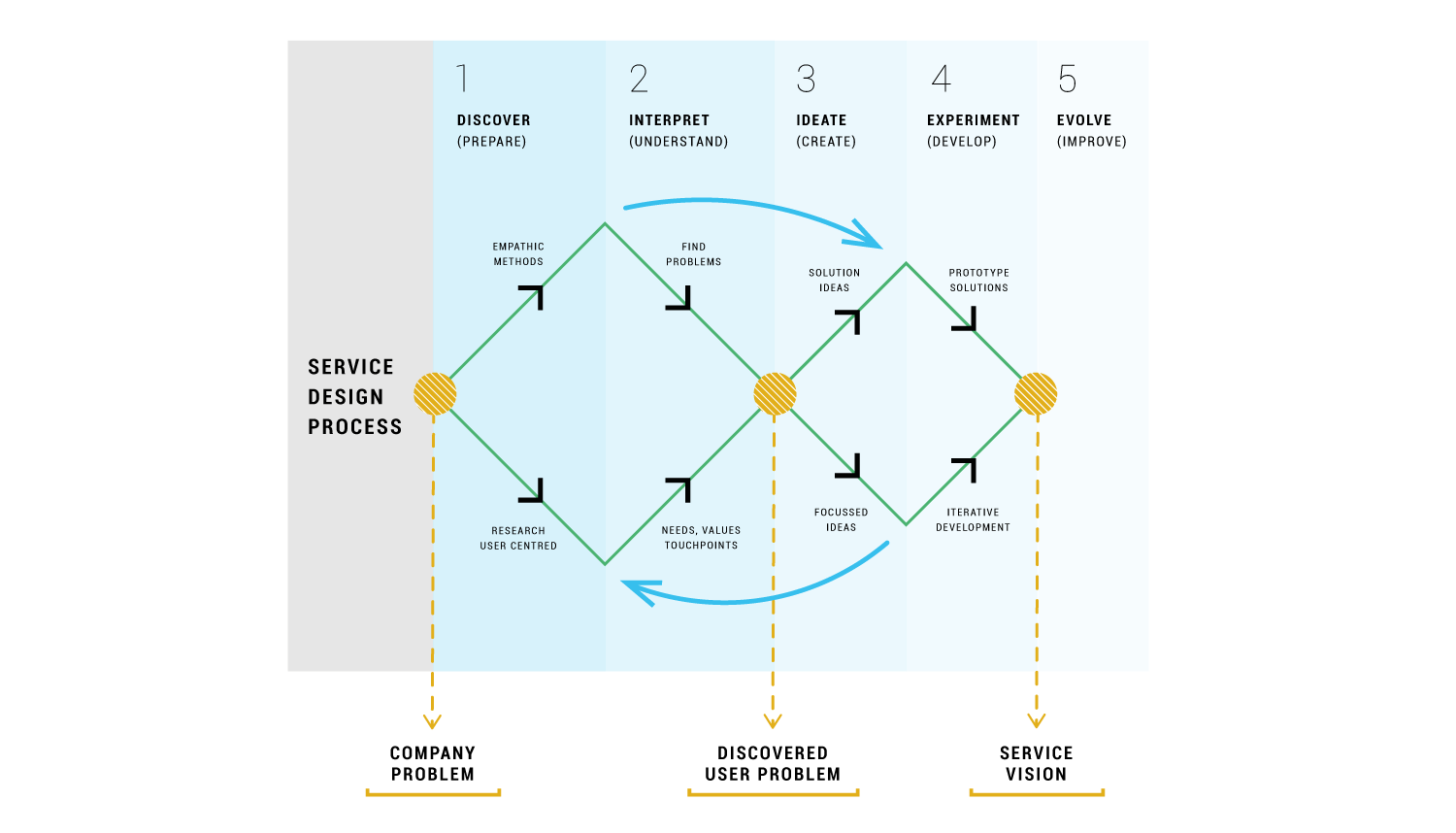
This is achieved by deploying structured design phases using the traditional double diamond process model of design, consisting of exploration and focussed thinking via discovery, interpretation, ideation, experimentation and evolution with iterative development back and forth involving testing and refining concepts where needed.
iii. Tailored Design Research Process & Methodologies
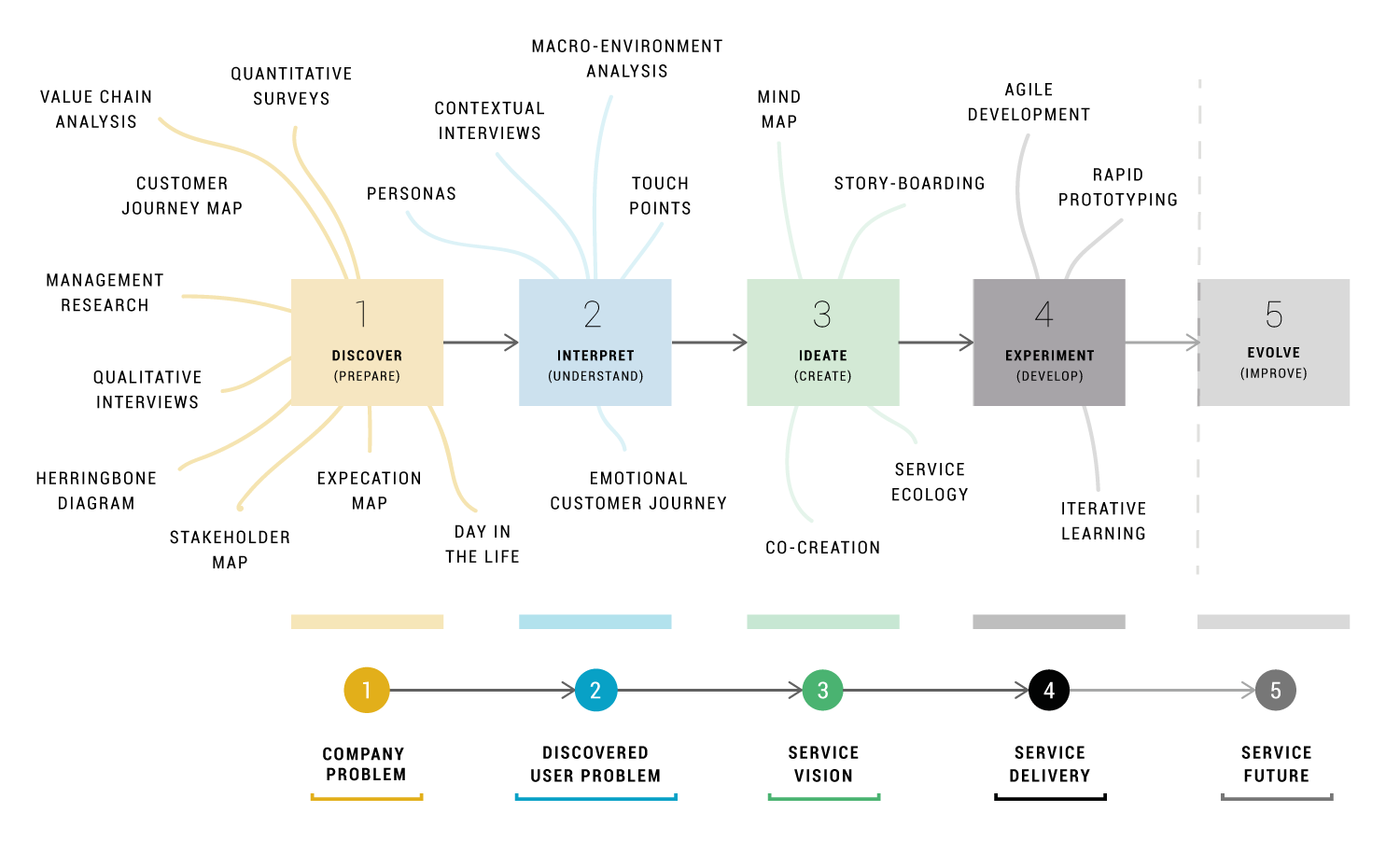
For this specific business problem which involves exploratory research of and in the macro-environment, a variety of tools and methodologies tailored to the underlying nature of the overall strategic business goal were developed, designed to understand and uncover key insights and relevant touch points.
In this specific context spanning primary innovation management research, value chain impact analyses, environment mapping techniques, qualitative interviews, empathic research methods, cultural probes, rapid prototyping, CX (including UX & UI) using service design principals.
Phase 1: DISCOVERY
The discovery phase incorporates a variety of broad research tools, methods and structured processes to gain deep insights through primary and secondary data research, theoretical understandings, issue mapping to allow for wider user empathy building.
Value Chain Analysis
The nature of potential impact upon each aspect were explored and detailed through further analysis to inform strategic business management and planning.

Service design methods are of particular importance here as they incorporate all stakeholders in the design and prototyping process iterations.
Innovation Management Research
An often over-looked resource of knowledge and insight can be found within high-impact leading research papers. Surveying the innovation management literature on open innovation, end-user innovation and user-communities brought few strategic management or theoretical insights into the specific challenges in this context: firms intending to incorporate external disruptive user-communities from autonomous, non-firm hosted platforms by hacker-consumers themselves.
To provide deep insight and understanding specific to this strategic problem, I conducted qualitative innovation management based upon grounded theory research in order to understand the exact role of disruptive end-user hackers and consumers on internal R&D teams specifically within smartphone device manufacturing firms, with particular emphasis on how knowledge types and sources are transferred.
Primary research findings were crucial to understanding the challenges faced by both firms and hacker-innovator users by gathering, analysing and interpreting primary data through qualitative semi-structured interviews, surveys, questionnaires and secondary data analysis, abstracting to higher levels to understand the phenomenon more broadly as well as making theoretical predictions. In total 19 in-depth semi-structured interviews were undertaken with hacker-consumers; 300+ quantitative and qualitative survey questionnaires and content analysis of over 4,800+ pages of secondary data. Use of CAQDAS software, Nvivo 10 was crucial in managing and analysing the vast amounts of primary and secondary data. Overall, this management research drove exploration and discovery of key-insights as well as contributing new innovation management knowledge to academia and industry alike.
Research Paper: External hacker communities and industry-wide innovation sources: The role of disruptive, autonomous end-users and consumers on internal R&D teams within device manufacturing firms.
Abstract
In a study of hacker innovation communities and their influence internally on firms, it is found that strategically significant codified feature-based knowledge generated externally by hacker communities is absorbed by firms through passive, non-engaged transfer to internal R&D departments for use in future product innovations via a process of covert community free-riding without formal engagement policies.
The major contribution is to describe the knowledge creation process types between hacker communities and firms including value transfer dynamics in a conceptual framework.
It is argued that community free-riding occurs due to perceptions of the originating intellectual property, organisational culture and policy, the nature and type of knowledge generated by hackers and anonymity of open access to external, highly-complimentary knowledge sources.
If you would like to read the research, download below:
Download Research PaperKey research paper insights uncovered
- The underlying nature in which knowledge is procured and absorbed across organisational boundaries from autonomous hacker communities via anonymous backdoor channels to firms.
- Causes for how and why knowledge is absorbed in this way.
- Divergent organisational reasons to exist and consequences for both firms and hacker communities.
- Conditions under which firms may be more likely to facilitate and discretely-absorb external innovation sources from hacker communities.
- Theoretical framework of external hacker innovation knowledge flows across organisational boundaries.
- Moderating factors of the phenomenon and future research directions in this area.
- Highlighting the case for development of service design solutions and tools as a strategic asset to facilitate overt absorption of codified knowledge using distributed digital technologies
Resulting Theoretical Framework

Theoretical framework of external hacker innovation knowledge flows across organisational boundaries.
Knowledge Flows
How hacker community knowledge is procured and absorbed across organisational boundaries for use in future product development and releases.
Personas & Day-in-the-life
Having carried-out 19 semi-structured interviews and 300+ qualitative and quantitative survey-questionnaires with a range of external hackers and users, personas were developed in order to visualise customers and consumers as recognisable archetypes.
- PROFILE 1: Phillippe, aged 37 from Munich, Germany (software engineer)
- PROFILE 2: John, aged 22 from Boston, US (full time student)
This enables higher forms of empathy to understand needs and desires in the collection and gathering of deeper insights for designers to use and engage with seemly ‘real’ people. Typical day-in-the-life data was also added to encapsulate day-to-day experiences and daily activities to gain deeper insights into imaginary and real user experiences.
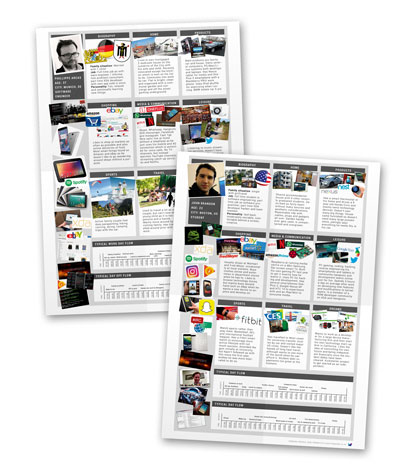
Phase 2: INTERPRET
The interpret phase involves understanding the meanings and linkages generated from the initial discovery phase specific to the wider organisational problem being addressed.
Mind Mapping
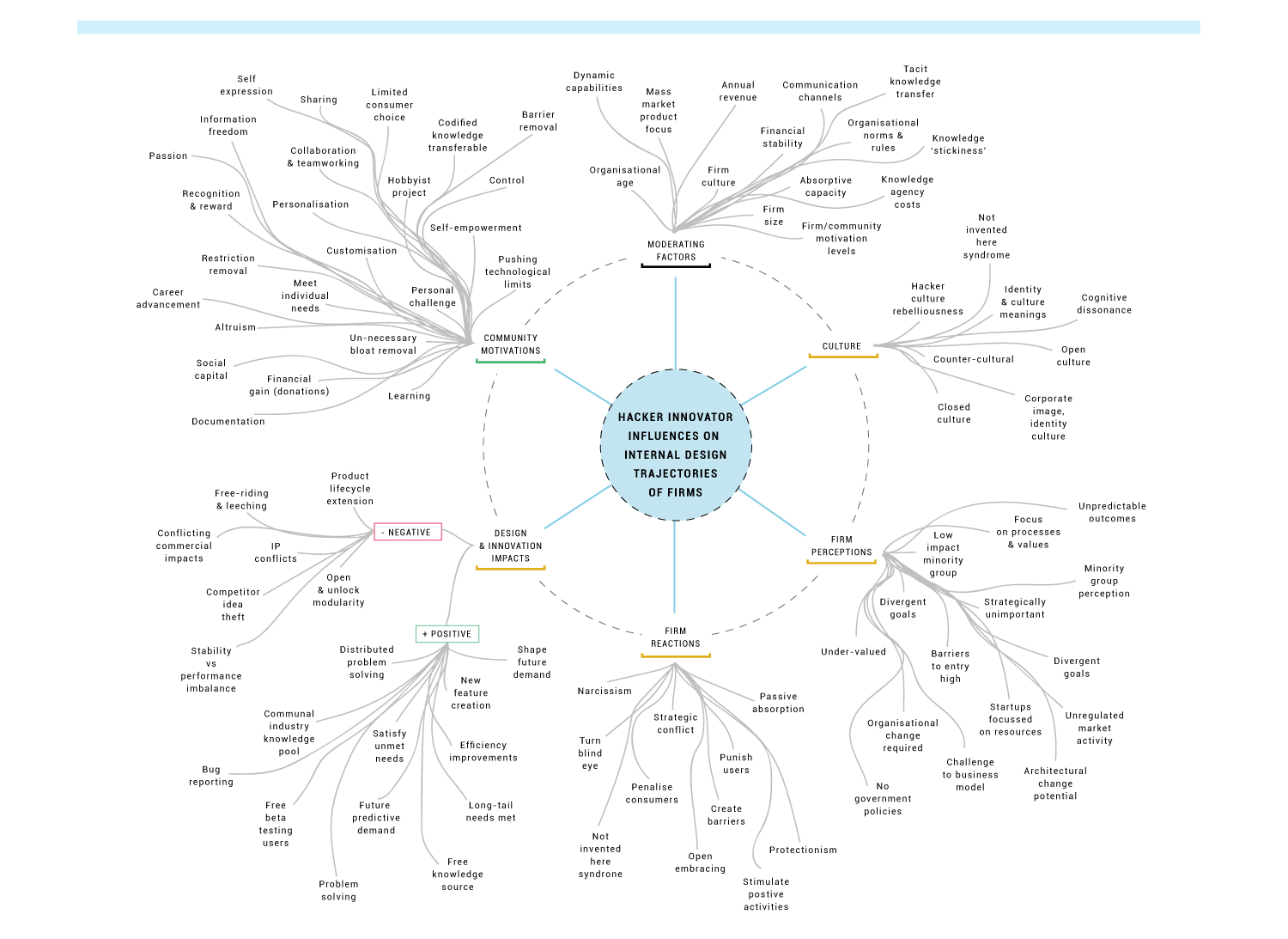
This was particularly useful as only key ideas are represented through free association of concepts, allowing for efficient, creative understandings of linkages for discussion to emerge with management and inform the subsequent design iterations. Overall this revealed many underlying organisational and legal challenges, with potential sources of divergent motivations and thinking that could negatively impact the deployment and adoption of boundary-spanning knowledge systems.

Stakeholder Mapping
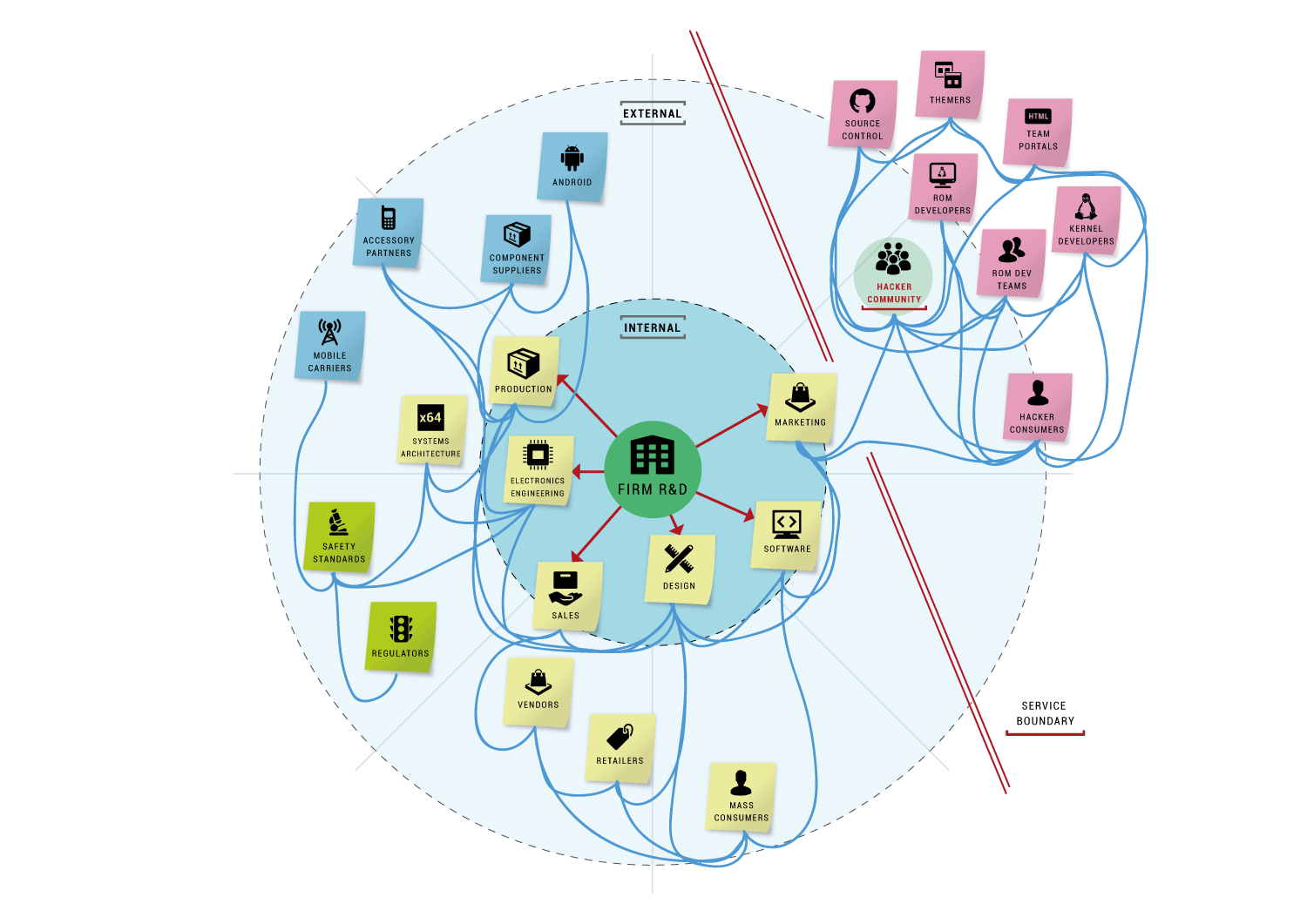
This revealed potential pain points, issues and concerns for discussion for each stakeholder group. From here participant groups could be clustered by importance and influence to inform the design of the initial service map.
Herring Bone Cause & Effect Diagram
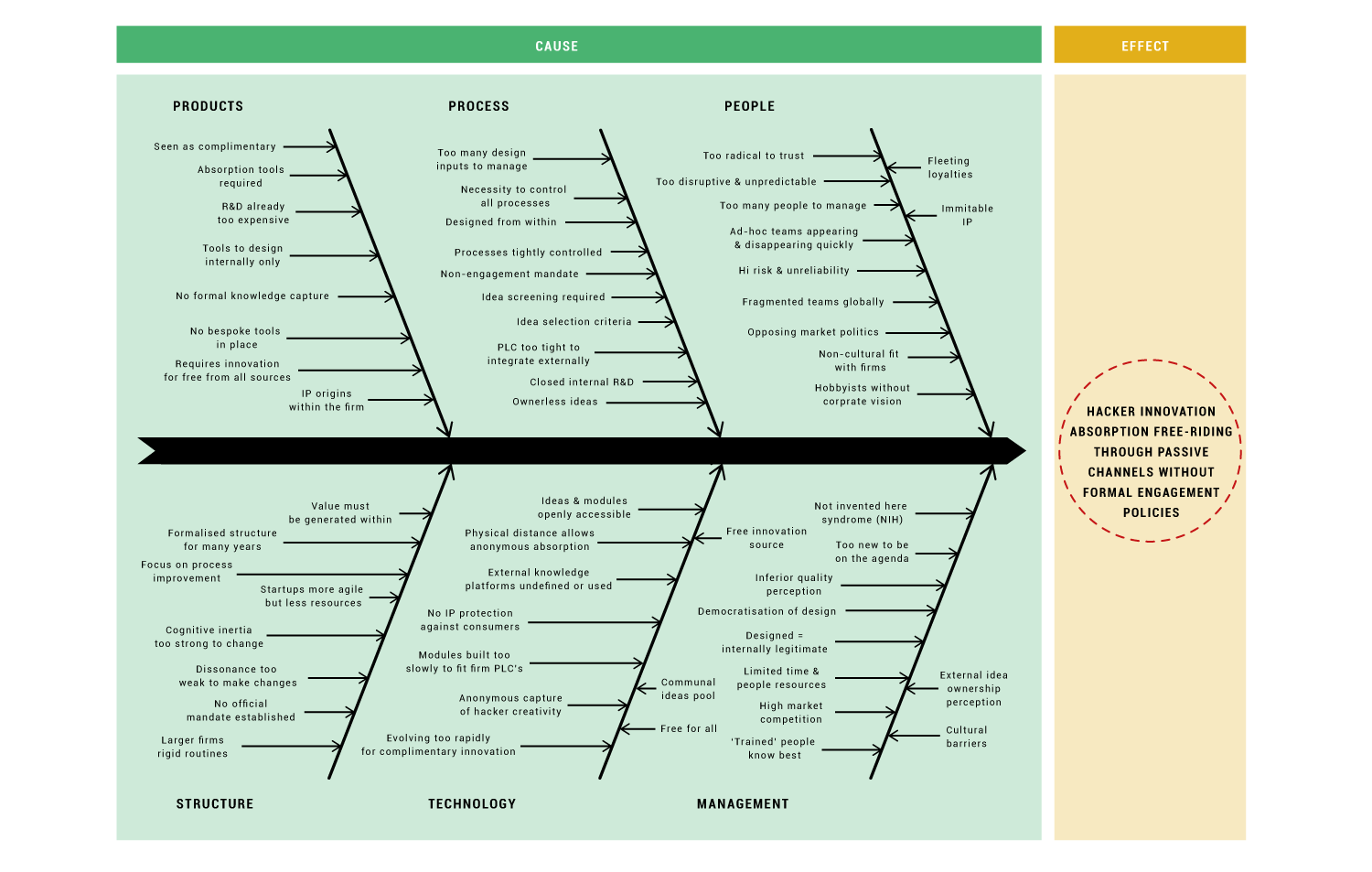
The main cause categories were derived from key insights generated by the discovery and mapping phases and made relevant to the key areas of overall impact in the organisational and community problem areas.
Customer Journey Map
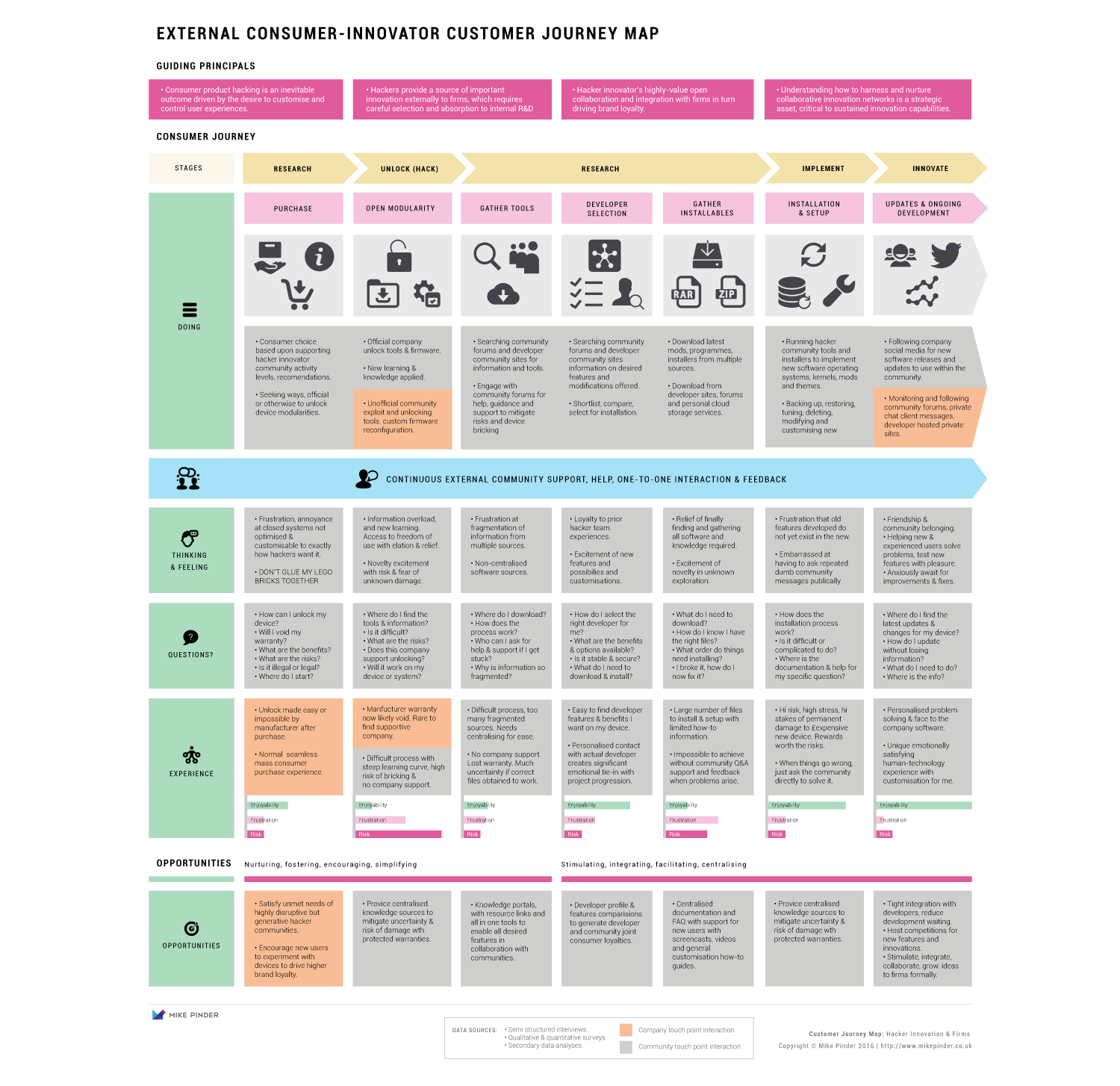
Journey maps provide a high-level view of broad factors that can influence user experience from the user’s perspective to help uncover circumstances, stages, motivations and experiences in the process of undertaking tasks.
This was particularly important for this design process as much of the innovation occurring in external user-communities is built and developed by those communities, in often fragmented and distributed tools and platforms. Understanding this landscape was therefore crucial to the success of a new platform that could address and solve existing underlying problems and issues.
Download a PDF version of the customer journey map above.
Based upon primary and secondary data research and ethnographic shadowing, visualisations of the current user experience in the journey map acted as a state-of-the-art sequential touch point analysis, detailing key interactions as well as emotional responses to reveal pain points, frustrations, risks, levels of enjoy-ability and highlighting insightful areas of opportunity for firms to innovate upon.
Of particular interest to solve were degrees of risk, complexity and frustration felt in gathering basic data, information and tools early-on in the hacker process contrasted by levels of enjoyment and reduced uncertainty later on in the hacker innovation process cycle.
Key questions from the customer journey map:
- What are people really trying to achieve?
- How are people really trying to achieve this?
- What do they use and in what order?
- Why do they make a specific choice?
- What are they thinking, experiencing, feeling whilst trying to reach their desired outcome?
Phase 3: IDEATE
At this stage a thorough understanding of the organisational problems was reached, coupled with user-centred research to reveal key problems, needs, values, processes, stages and touch points to design. In this phase, solution-based ideas are focussed back-in to drive iterative problem solving of new solutions to the service problems.
Issues, Features & Requirements
Insights drawn from the discovery phase highlighting the existing status-quo including service design challenges, pain-points and sweet-spots via data collection and analysis derived from user research methodologies (innovation management research both quantitative and qualitative, empathic user research methods, process and stakeholder mapping techniques as detailed).
New service touch points detailing features and requirements were established for both communities and firms alike, revealing areas of overlap, complementarity and opportunity to design and develop, split into use stages and features.
Key issue cards to address:
- Fundamental opposing reasons to exist for both hacker communities and firms, stemming from the desire for information freedom and the control of IP to drive profit generation.
- Collaborative innovation strategies for smaller firms being more open whilst larger market share firms being closed. As the firm matures and gains higher market share, the increasing tendency for process control of IP requires management and mitigation within the future service development.
- Knowledge is currently transferred across organisational boundaries covertly through informal and distanced back-door channels. The service will need to make knowledge transfer explicit, not implicit.
- Where ever possible, hackers should not have restrictions put in place in the pursuit of improved technologies and experiences. Pain points should be highlighted early and removed through iterative refinements to the overall service.
- Acknowledgement of the differing rights of community inputs and ownership of resultant IP generated externally as a communal pool of knowledge.
Key Community-Firm Touch Points
Community Touch Points
- PURCHASE
- Tradition channels (stores, online)
- OPEN MODULARITY
- General public information portal – application & registration
- Login information portal – authorised users
- Access to source control
- Company development tools & packages downloads
- Bootloaders
- Device trees
- Kernels
- ROM firmware source code
- Firmware radios
- Unlock tools
- SDK tools
- Pre-release builds & betas
- GATHER TOOLS
- Community developed download hosting repositories
- Company development tool downloads
- Bootloaders
- Device trees
- Kernels
- ROM firmware source code
- Firmware radios
- Unlock tools
- SDK tools
- Pre-release builds & betas
- DEVELOPER SELECTION
- Recommend a developer/team member referrals
- Developer profile homepages
- Recommend a developer/team member referrals
- GATHER INSTALLABLES
- Community developed download hosting repositories
- Company download packages
- INSTALLATION & SETUP
- Collaborative tutorials
- API referencing
- Wiki articles
- Device roadmaps
- UPDATES & ONGOING DEVELOPMENT
- Member only meetups and events
- Idea competitions
- Cases and bug tracking, commenting, resolution
- Free hardware competitions
- Crowd and firm voted/funded development projects
- Bug fixes and submissions
- New feature voting, requests & submissions / Unmet needs lists
- Forums
- Social media channels (YouTube, G+, Hangouts…)
- Community outreach team members
- Access to full code documentation (device trees)
- Community/developer private forums
- Developer booking system sessions
- Developer messaging channels
- Direct private messages
- Live collaborative chat
- Critical feedback & research findings to developers
Company Touch Points
- PROVIDE TOOLS
- Bootloaders
- Device trees
- Kernels
- ROM firmware source code
- Firmware radios
- Unlock tools
- SDK tools
- Pre-release builds & betas
- PROVIDE DOCUMENTATION
- Access to code documentation
- Access to device tree documentation
- API referencing
- Wiki articles
- Device roadmaps
- Collaborative tutorials
- PROVIDE LIVE SUPPORT
- Community & developer private forums
- PROVIDE COMPANY/COMMUNITY INTEGRATION
- Community outreach members
- Recommend a developer/team member referrals
- PROVIDE INTERNAL DEVELOPER ACCESS
- Access internal software developers
- Messaging channels
- Direct private messages
- Live collaborative chat
- Developer booking systems sessions
- Access internal software developers
- SCREEN NEW EXTERNAL HACKER COLLABORATOR’S
- New feature request submissions
- PROVIDE FILE HOSTING
- Community developed download hosting repositories
- Company download packages
- CONTESTS, EVENTS, COMPETITIONS
- Member only meetups and events
- PROVIDE COLLABORATION REWARDS & INCENTIVES
- Idea competitions
- Crowd and firm voted/funded development projects
- PROVIDE HARDWARE TO DEVELOPERS
- Free hardware applications
- Free hardware competitions
- MONITOR COMMUNITY DEVELOPMENT & INNOVATION
- Unmet needs lists
- Cases and bug tracking, commenting, resolution
- FACILITATE KNOWLEDGE FLOWS EXTERNAL-INTERNAL
- Critical feedback & research findings to developers
- REPORT TO INTERNAL R&D FOR SCREENING & IMPLEMENTATION
- Bugs tracking & resolutions
- New feature voting & results
- Surveys
Service Design Blueprint
At this point, a detailed and informed service blueprint solution was developed through several iterations to propose a potential service outcome from a functional perspective, giving shape to the look-and-feel of how it will operate through a ‘living’ and visual document.
This is a critical stage of the service design process as it enables the categorisation and organisation of each aspect of the service proposition, visually highlighting in sequential form, the entire user-experience journey via key touch points, actions, front and back-stage organisational processes and accompanying support mechanisms.
The blueprint documents the user journey stages specific to the organisational problem showing the linkages between features and functionalities over the entire anticipated service lifecycle period.
It can then be used to benchmark against the initial goals of the client OEM manufacturer in facilitating overt knowledge flow linkages from external hacker communities to internal R&D teams.
Download a copy of the blueprint below.
Phase 4: EXPERIMENT
Having developed a detailed service blueprint grounded in research insights triangulated by various data sources, perspectives using empathic methods, a clear vision was established into the exact nature of the proposed solution. From here, rapid service prototyping, development and iterative learning could take place, revising and improving the overall blueprint where necessary.
Lean & Rapid Prototyping

Based upon the living service blueprint, features, functionalities and requirements, the initial user-experience service design structure was developed.
From here, quick-and-dirty layouts, UI wireframes and mock-ups were produced initially on paper to rapidly and cheaply explore possible visual solutions. Informational layouts allow for simple, logical and abstract data organisation without getting bogged-down by the need to produce polished-looking prototypes.
More detailed UI mock-ups were then created to allow for actual user interactions to take place by simulating the actual service experience using latest cross platform Web technologies (HTML5, CSS3 and JavaScript) in Axure and Adobe Animate to test on all devices (desktops, smartphones, tablets). Rapid iterative learning-by-doing could then take place by broadly testing and refining ideas with all stakeholders, generating deeper understandings of user experiences by efficiently and cheaply testing in the wild before moving to the expense of real implementation.
This highly-adaptable AGILE development phase allowed for emphasis upon individual’s and their interactions instead of a focus on tools and process implementation. At this stage it is essential that the service is adaptable to allow for simple evolutionary changes based upon newly revealed problems and their subsequent solutions.
Once finalised, mock-ups were developed and extensively tested with a broad selection of stakeholders both internally with designers, engineers, marketers, customer support; and externally with hackers, developers, teams, lead-users.
More polished UI representations could then be developed and incorporated into the mock-ups to give finalised look-and-feel interaction testing, experimentation and further refinement iterations before signing-off and handed over for real-world implementation.
The last stage involves the development of underlying technology infrastructure, software architecture, software development, front and back-end coding development work.
Phase 5: EVOLVE
The last phase involves continual service evolution and evaluation cycles of re-iteration and refinement once the initial service has been technically implemented following alpha and beta testing stages with internal development teams and end-users (in this case users of high technical understandings and abilities within hacker communities).
Inevitable improvements, tweaks and changes will be necessary as part of continual, on-going service improvement based upon broad stakeholder feedback with new feature requests and incremental needs to be addressed.
Summary
Despite contractual restrictions in detailing previous work, I hope that by explaining my approach to analysing and implementing solutions within a specific context (spanning innovation, design, business and technical challenges), you will have a better understanding of how my knowledge, skills and expertise overlap and are applied in situe.


